The last appearance by WWII German tanks on the world’s battlefields came in 1967, when Syria’s panzer force faced off against modern Israeli armor. Quite improbably, Syria had assembled it’s collection of ex-Wehrmacht vehicles from a half-dozen sources over a decade and a half timeframe.

(Syrian army Panzer IV tank)
the Panzer IV (PzKpfw. IV)
This was the most common German tank during WWII. It served the entire conflict from start to finish. It underwent great evolution during it’s production run, being made in ten main versions. The Panzer IVs Syria operated were of the late four versions.
All of the Panzer IVs Syria used had the “long-barrel version” of the Rheinmetall KwK 40 gun which could penetrate a M4 Sherman’s armor at ranges up to 1,000 yards under ideal circumstances. The WWII-era TZF.5f gunsight was retained by the Syrians. A full ammo load was 87 rounds. There were two secondary machine guns, either MG-34s or MG-42s, one coaxial and one in a ball mount in the tank’s nose.
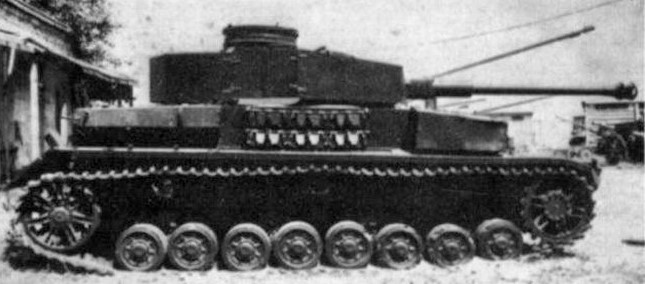
(Panzer IV Ausf H of the Syrian army. The spare tread links were both a breakdown recovery item, and added a bit of extra armor for the crew. A few links were carried on the right side, and more on the front glacis.)
The PzKpfw. IV weighed 27 ½ tons and was 19’5″ long (23′ including the gun barrel). It had a 5-man crew. The armor varied, being 3″ on the glacis and turret face, 1¼” on the sides, and ¾” over the engine compartment’s rear. The electrically-traversed turret was offset about 2½” to the left to counteract a slight rightwards orientation of the engine. A snubnose 92mm barrel in the roof allowed the firing of smoke grenades or signal flares.
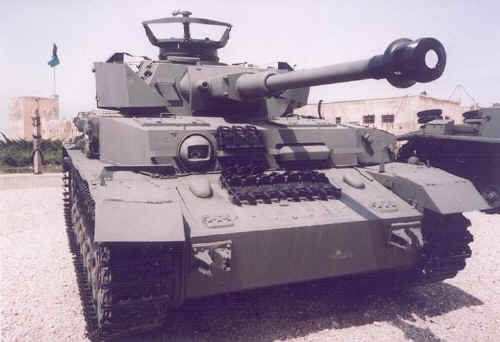
(Syrian Panzer IV Ausf H captured by Israel. Most military historians consider this the best of the Pz.Kpfw IV models.)
The Ausf J version, made by Germany late in the USA’s bombing offensive, lacked some features including the 92mm launcher and the turret drive motor; relying solely on the emergency handwheel. This version also had solid-steel roadwheels, making driving on pavement unpleasant for the crew.

(This Panzer IV Ausf J was captured intact by Israel in 1967 and today is a monument in Migdal Ha Emek, Israel. The Ausf J was actually a step backwards from the Ausf H version. The green rustproofing paint was added by the town and is not authentic.)
The powerplant was a Maybach HL 120TRM 12-cylinder, 296hp gasoline engine. All of the Syrian Panzer IVs had the SSG 77 six-speed transmission. The Panzer IV had leaf spring suspension, which, by the time of the final versions like Syria used, was at it’s limits with the added weight of the modifications. The maximum speed was 26mph but by the 1960s, these tanks were rarely driven faster than 10mph due to their age and the overloaded suspensions.
from France
The number of Panzer IVs from France is uncertain. One source lists 40 being delivered, while others state the the 40-vehicle total Syria got from France was a combination of all German types including Panzer IVs, and the number of ex-French Panzer IVs was only 11 or even less than that (one source says only 5). Yet another source says that indeed 40 were delivered, but, by the time of Syria’s second round of WWII German weapons imports later in the 1950s, only a handful of the French-delivered Panzer IVs remained functional.
As listed in the somewhat muddled French export records, all were of the Ausf H version however some may have been of other versions. reportedly one was a “Frankenstein” with the Ausf J hull, suspension, and propulsion; mated to an older Ausf D turret but with the “long-barrel version” KwK 40 shoehorned in. France’s Panzer IVs were either battlefield recoveries or captures, and all had obviously seen action during WWII. The French tanks had seen some post-WWII use by the French army and a number had been repaired using pieces of other wrecked Panzer IVs. Some were missing equipment, notably the bow machine gun.
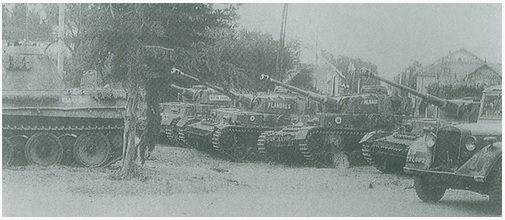
(Panzer IVs of the French army’s Besnier squadron in 1945.)
The French Panzer IVs belonged to the short-lived Besnier independent armor squadron, a hodgepodge of German, American, and French vehicles assembled during the country’s 1944-1945 liberation. Unlike the PzKpfw. V Panther (which equipped two post-WWII frontline French army regiments until 1950), the French had little interest in the Panzer IV and these tanks had likely been sitting in warehouses since late 1945. The date of the transfer is uncertain but was probably in 1950 or 1951. After the 1948 Israeli War of Independence, the French attempted to remain allies with both Israel and Syria. To that end, an attempt was made to “balance” a weapons sale to one side by an offer of something else to the other. As the Panzer IVs were just collecting dust anyways, they made an ideal item to offer Syria.
from Czechoslovakia
Immediately after Germany’s collapse in May 1945, the Soviet army established a staging area for surrendered German tanks at a former Wehrmacht barracks at Milovice, about 24 miles north of Prague, Czechoslovakia. By January 1946, a total of 165 operational Panzer IVs of varying versions were at this facility. Joining them was a huge cache of spare parts found at a former German tank repair depot in Teplice, along with ammunition collected from all over Czechoslovakia and the southern extremity of the Soviet occupation zone in Germany. Throughout 1946, the Czechoslovak government’s clean-up of WWII battlefields recovered another 102 Panzer IV wrecks, of which 80 were pieced back together to operational status. By January 1947, a total of 245 Panzer IVs were operational, now transferred to the Czechoslovak army.
These Panzer IVs were not segregated by variant and were of the Ausf D, G, H and J versions; and it was not uncommon for them to be “half-breeds” between the types, especially those repaired after WWII.

(A “half-breed” Panzer IV which Syria bought from Czechoslovakia. It has components of both the Ausf H and Ausf J versions. This individual tank had a remarkable life. It first served with the Wehrmacht on the Ostfront, then was captured and placed into service with the Soviet army, who used it in combat against the Germans in 1945. It was then transferred to Czechoslovakia which later sold it to Syria. In 1967 it was captured by Israel, and today is in an American museum which has repainted it in WWII German colors.)
In early 1948, the now-nationalized CKD Works began a limited upkeep of the tanks, many of which had not had depot-level overhauls since the war. A few were rebuilt with a Czechoslovak-designed steering system, but this effort was halted due to cost. These Panzer IVs remained operational in the Czechoslovak army until the end of 1954, when sufficient T-34s were available to phase them out.
A Syrian military delegation visited Prague from 8 April – 22 April 1955. An agreement was struck for the sale, amongst other items, of 45 Panzer IVs. Despite their obsolescence the Czechoslovaks were not about to just give the tanks away, and demanded payment in a ‘hard’ western currency, namely British pounds. The cost was £4,500 each (£86,000 or $112,850 in 2016 money), far above what they were probably worth militarily, especially considering the limited amount of foreign currency reserves available to the Damascus government. The deal included refurbishment, a full ammunition loadout for each, and a limited number of spare parts. The tanks were delivered to Syria in early November 1955.
The Syrians were by that time already having problems keeping their French-sourced panzers operational, and in 1958, a second contract was signed for 15 additional Panzer IVs, these being in lesser condition or non-operational, for use as spare parts hulks. An additional 16 refurbished Maybach engines were also included in this contract.
As they had been lumped all together in Czechoslovak army service, the Syrians received a mixed bag of versions, many of them “half-breeds” or “Frankensteins”. Many had the bow machine gun removed; in some cases the coaxial gun as well. It doesn’t appear that the Czechoslovaks updated the radio fit on these tanks.
Czechoslovakia restarted production of the Schürzen spaced turret armor kit. This was a ring of sheet steel plates set off from the turret. Today, this is often described as a German defense against HEAT rounds (as modern spaced armor is) however this is untrue; when the Schürzen kit was designed during the middle part of WWII, HEAT rounds were not commonly encountered. Instead it was intended to give additional protection against light anti-tank guns by slowing the incoming round and altering it’s trajectory before it struck the turret itself. The Schürzen had little effect against Cold War-era HEAT bazookas and anti-tank missiles, and was obviously of no use against tank gun rounds.
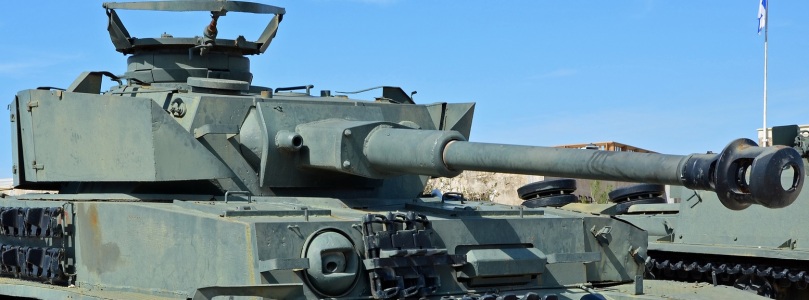
(The Schürzen 8mm turret skirts on a Syrian Panzer IV captured by Israel in 1967.)
The Czechoslovaks also delivered an adapter kit to allow use of their AA crescent mount for the Soviet-made DShK 12.7mm machine gun. This AA mount was developed after WWII for the T-34 tank. The adapter allowed it to be fitted onto the Panzer IV’s commander cupola. These kits were fitted to all of the initial 45 tanks of the 1955 order and enough were delivered that some could be installed on a few of the Spanish- / French-sourced tanks as well.
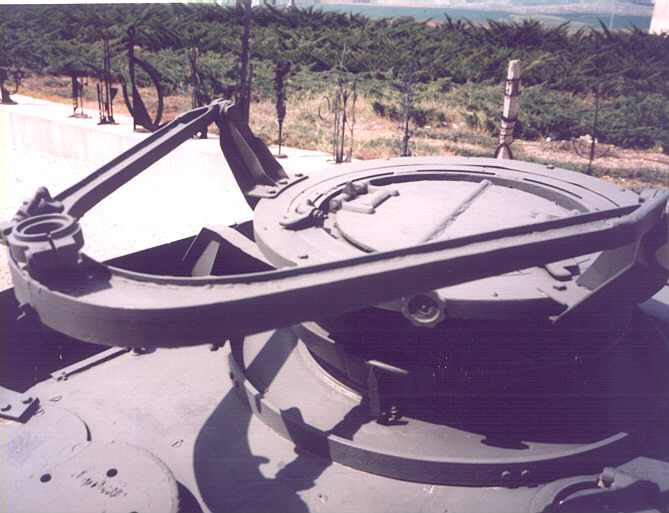
(The Czechoslovak-made AA mount for the DShK AA gun and it’s adapter braces for the Panzer IV cupola.)
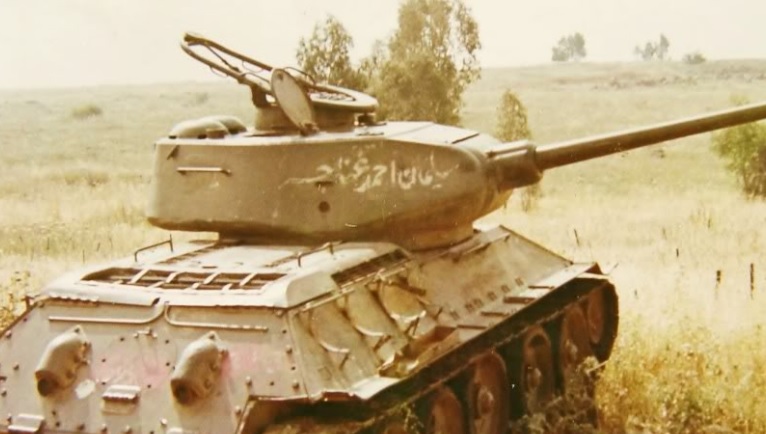
(For comparison, the AA mount in it’s more common use, aboard a Syrian T-34.)
Inclusive of the cannibalization hulks, Syria received a total of 60 Panzer IVs from Czechoslovakia. At no time were all simultaneously operational and by 1960, usually only two or three dozen were combat-ready.
from Spain
For certain, seventeen of Syria’s Panzer IVs came from Spain, which kept detailed export records down to the individual serial numbers. All of the Spanish tanks were of the Ausf H version, with the 75mm “long-barrel version” KwK 40 main gun. These tanks were part of a 20-vehicle order of Panzer IVs delivered to Spain during WWII in 1943. These were top-line tanks identical to the Wehrmacht version, and had all of the Ausf H features including the enhanced transmission, additional armor, and cast sprockets. When sold to Syria, they were all still completely in the original German WWII configuration. All were delivered to Syria in December 1965. The Spanish Panzer IVs had been immaculately maintained in Spain, and had never seen combat. These were the best of the lots which Syria operated.
Syrian changes
By the time of the Six Day War, very few of Syria’s Panzer IVs still had the bow machine gun and according to the Israeli Defense Forces, some also lacked a coaxial machine gun. An IDF report on one captured Panzer IV said that it had a nameless “Soviet .50cal coaxial”. The DShK 12.7mm machine gun was larger and longer than the German machine guns, would have been quite difficult (but not impossible) to shoehorn into the turret. A different (less likely) possibility is the Berezin UB, a Soviet 12.7mm aircraft gun of WWII. This gun was smaller and lighter than the DShK.
Regarding the bow machine gun, a very few wrecks examined after the war still had the WWII German weapon, while a handful had a Soviet Degtyaryov DS-39; a WWII-legacy Soviet 7.62mm machine gun of similar size to the German weapons. The vast majority had no bow machine gun at all, with the ball mount either empty or plated over.

(A captured Syrian Panzer IV Ausf J in Tel Aviv, next to a captured Egyptian T-34. This shows the empty ball mount for the bow machine gun. Reportedly, this was the Panzer IV which the IDF said had a Soviet coaxial machine gun retrofitted; the type of which was not disclosed.)
It’s unclear if the Syrians installed modern Soviet radios in any of their Panzer IVs. The WWII German Fu 5 radio required a dedicated operator (who also manned the bow machine gun); if a more modern system was installed not requiring a dedicated operator, this crew position could be eliminated altogether on tanks missing the bow machine gun.
the StuG III
The Sturmgeschütz III was an armored assault gun of WWII Germany. In English, “Sturmgeschütz” directly translates as “assault gun” and in fact this vehicle established the entire assault gun category when classifying military vehicles. The “III” refers to it’s use of a Panzer III chassis; there was no I or II. This was the most-produced vehicle of this type by any of the Axis nations during WWII.
The assault gun concept combined the roles of self-propelled artillery and towed anti-tank guns. It’s main weapon, the 75mm StuK 40 gun, could fire either HE fragmentation field gun rounds or armor-piercing anti-tank rounds. Compared to a dedicated tank destroyer, the gun’s velocity was less but probably still sufficient (it could defeat the turret armor of a M4 Sherman at 900 yards). Compared to a normal artillery piece, it’s range was less, but again sufficient. In turn it combined the attributes of both in one package. As envisioned, StuG IIIs would support attacks by taking out pillboxes, mortar nests, and light combat vehicles, while acting as a rally point for infantry. On the defense, it would lie in wait to ambush enemy tanks.
The StuG III weighed 26 ¼ tons and was 22’6″ long. It had a 4-man crew. The 75mm StuK 40 gun had 54 rounds of ammo and a range determined by the target type and ammunition style used; usually not more than 2 miles and never more than 3 miles. The gun could only traverse about 13° to either side; beyond that the whole vehicle had to pivot. The secondary armament was a MG-34 machine gun in an anti-aircraft mount; some also had a coaxial MG-34. The StuG III was powered by a Maybach HL-120 12-cylinder gasoline engine and had a top speed of 25mph. The armor ranged from ½” to 3¼”, with the bulk of it on the front glacis.
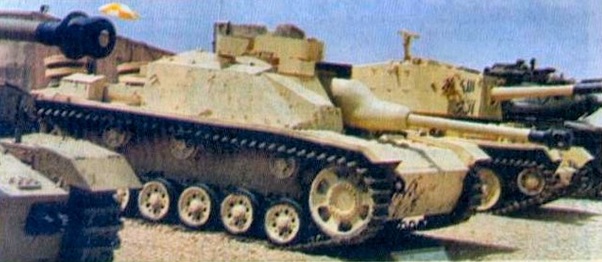
(A Syrian StuG III Ausf G captured by Israel in 1967.)
Syria operated a total of 28 StuG IIIs at one point or another (never all 28 simultaneously). There were always about a half-dozen or so additional vehicles on hand as non-operational spare parts sources.
The Syrians modified their StuG IIIs by adding a pintle for a Breda SAFAT heavy machine gun. This air-cooled, belt-fed machine gun fired the 12.7x81mm(SR) cartridge at 700rpm with a 2,510fps muzzle velocity. The SAFAT was designed for either ground or air use, but was most famously employed as the wing guns in WWII Italian fighter aircraft. The Syrian air force operated some ex-Italian warplanes after WWII; when they were scrapped in the 1950s the guns were saved for reuse.

(Syrian StuG III in the early 1960s with the locally-designed mount for the Italian SAFAT machine gun. Also of note, this StuG still has the WWII German “Zimmerit” anti-magnetic coating on; it can be seen clearly around the area scraped clean for the Syrian serial number. Zimmerit was a paste which tended to come off over time.)

(The Breda 12.7mm SAFAT machine gun out of it’s housing.) (official US Navy photograph)
from France
Syria bought nine StuG IIIs from France in 1950 or 1951. Like the ex-French Panzer IVs, these vehicles had belonged to the Besnier unit and, undesired by the post-WWII French army, were put into storage in the late 1940s. The exact submodel is unknown; most likely they were of the Ausf G version but possibly some were of the earlier Ausf F model.
The StuG IIIs from France were no doubt in the worst condition of the four source countries Syria obtained the type from. All nine had been used in combat by the Wehrmacht during WWII, and had received very little upkeep from the French afterwards.
from Czechoslovakia
Czechoslovakia obtained it’s StuG IIIs similar to the Panzer IVs, as described above. Besides the Milovice collection point, the Germans had a specialized StuG III repair depot at Decin, Czechoslovakia which was captured relatively intact by the Soviet army in 1945, including some StuGs undergoing repairs. At the conclusion of the post-WWII repair effort, the Czechoslovak army had a peak strength of 126 operational StuG IIIs. Czechoslovakia retired it’s StuGs in November 1953 and sent them to storage.
Twelve (plus the ex-Romanian vehicle below) Czechoslovak StuG IIIs were sold to Syria and delivered with the first batch of Panzer IVs in November 1955. All were of the StuG III Ausf G version. Unusually for Czechoslovak arms exports, fairly detailed records were kept on this deal and the Czechoslovak army register numbers (but not German serial numbers) are known. The price was £3,250 each (£61,513 / $80,664 in 2016 money). At the same time, another ten non-operational StuG IIIs were delivered for use as spare parts hulks.

(Syrian army StuG III in the early 1960s. This shows the SAFAT mount in addition to the WWII-standard MG-34 mount.)
According to one Czech military historian, in November 1956 another ten or twenty (the engines may have been counted separately from the hulls) degraded or non-operational StuG IIIs were delivered from Czechoslovakia to Syria for parts, as the Syrians were apparently having major problems keeping their StuGs running. If this is true, these probably replaced the ex-French vehicles in the twenty-eight total. They may have also accounted for some of the non-operational StuG IIIs the Israelis encountered buried as pillboxes.
from Romania
One Syrian StuG III was ex-Romanian. This country, when it had been an Axis ally during WWII, actually used the StuG III in combat. Like many of the Warsaw Pact countries, Romania briefly operated ex-German weaponry in the late 1940s and early 1950s. By most accounts, Romania had sent this StuG III to Czechoslovakia as the guinea pig for a possible modernization program to be done there; that in the end was cancelled. It was then sold to Syria and shipped along with the ex-Czechoslovak StuGs.
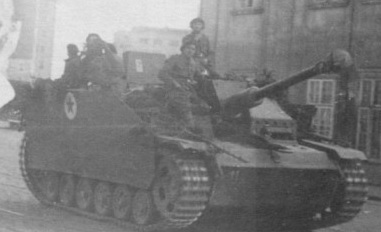
(A StuG III during a communist parade in Bucharest after WWII, when Romania’s roundel was an inverse outline of the Soviet star.)
from Spain
Spain obtained a handful of these vehicles during WWII, at the same time as it’s Panzer IVs. In December 1965, Spain sold six StuG IIIs to Syria. The StuGs from Spain were still in their original WWII German configuration.
the Jagdpanzer IV
Syria operated six Jagdpanzer IV tank destroyers, all of the original version. Only 784 of this version were built, all during 1944, before production switched to the more famous upgunned version.
The version operated by Syria had a PaK 39 L/48 75mm anti-tank gun with 79 rounds of ammunition. The Jagdpanzer IV was a “casemate”-style turretless vehicle. Compared to a tank, the advantage was that more armor could be concentrated forward. It also had a very low (6′) silhouette. As it had no turret ring or traverse drive, it was also cheaper to build. The obvious huge disadvantage was that the gun could only move 12° either direction; beyond that the whole vehicle had to pivot on it’s tracks to aim.

(Syrian army Jagdpanzer IV on parade in Damascus.)
Like all “casemate”-style tank destroyers of WWII, the Jagdpanzer IV put as much armor as possible forward at the expense of everywhere else. The frontal glacis was between 2″-2 ¾” thick hardened steel and the massive gun mantlet was over 3″ thick, but the remainder of the Jagdpanzer IV had 1 ¼” or thinner armor. Face-to-face, this tank destroyer was very formidable during WWII, but if it was outflanked faster than it could pivot on it’s tracks (or surprised from the sides or rear) it was in trouble.
The secondary armament was a MG-34 machine gun with 600 rounds. The Jagdpanzer IV had a 4-man crew, and was powered by a Maybach HL-120 12-cylider gasoline engine with a top speed of 25mph. It had 99-shoe steel tracks of 400mm width, and leaf spring suspension. This was a clever and well-built vehicle, for example it could ford rivers as deep as half of the vehicle’s own height.
The six Syrian Jagdpanzers came from France in 1950. Presumably, they had been part of the short-lived Besnier unit, although it’s possible they were recovered from battlefield clean-ups or even in the French occupation zone after WWII. The post-WWII French army had no interest in the type. They were lumped into a larger weapons sale to Syria that included artillery shells, small arms, and the such; and little else is known about the deal.
the Hummel (Sd.Kfz. 165)
Syria operated five Hummels. All came from France, and were delivered along with the Jagdpanzer IVs in 1950 as described above.
The Hummel (bumblebee in German) self-propelled artillery was developed during the middle part of WWII. It weighed 26 ½ tons. The main weapon was a 150mm sFH 18 howitzer, which fired a 96 lbs HE shell to ranges of up to 8 ½ miles. Unlike earlier German self-propelled artillery, the “bottom half” was not a converted tank hull but rather a purpose-built chassis known as Geschützwagen III/IV. It was powered by a Maybach HL-120 12-cylinder gasoline engine and had a top speed of 26mph. The Hummel had a 6-man crew: the driver, the commander, and the 4-man gun team. Like most SPAs, the Hummel was not intended to face direct enemy fire and the open-top armored compartment was only about 1″ (or less) thick, sufficient only against small arms fire. A MG-34 machine gun was carried for emergency close-in situations.

(A Syrian Hummel aboard a tank transporter lowboy. Even by the late 1950s, the Syrians were doing everything they could to limit the mileage put on the aging WWII tracks and suspension.)
One drawback was that only 18 howitzer rounds fit inside the Hummel. A specialized tracked support vehicle, the Munitionsträger H, was supposed to follow Hummels into battle but as the Syrians had none of these, ammunition replenishment would have been at the mercy of unarmored wheeled trucks.
Only a limited amount of captured German ammunition was provided by the French. During the 2014-2016 Syrian Civil War, WWII German 105mm leFH 18M artillery guns used by the Ahar al-Sham islamic rebels were observed firing shells with cyrillic markings, so it stands to reason that the Syrian Hummels were likewise filled with Soviet reverse-engineered copies of WWII German shells during the 1960s.

(Syrian army Hummel with the SAFAT mount installed.)
At least one of the Syrian Hummels had a WWII Italian Breda SAFAT 12.7mm machine gun installed in a makeshift AA mount, similar to those on the StuG IIIs as described above.
the Sturmpanzer II (Bison)
It’s not entirely certain that Syria operated this self-propelled artillery at all. If it did, it would be quite remarkable as it was one of the rarest armored vehicles of WWII, with only fourteen plus one prototype known to have been built.
The Sturmpanzer II was a follow-up to the Sturmpanzer I (also nicknamed Bison) intended to give German artillery increased mobility. Weighing 17 ½ tons, it was merely the hulls of obsolete Panzer II tanks mated with 150mm sIG 33 howitzers. There was no armor for the open top compartment, only thin sheet steel to protect the 4-man crew from shell fragments. The Sturmpanzer II could go 28mph on paved roads but was limited to just 9mph cross-country. The howitzer’s range was 2 ¾ miles and only 10 rounds of ammo were carried.
All fourteen were issued to the Afrika Korps in April 1942. Eight were destroyed in combat, and the other six were abandoned in 1943 due to mechanical breakdowns.
Of the six inoperable examples not destroyed in combat, several and maybe the whole half-dozen were recovered by the British army and moved to Egypt, where they remained after WWII ended. The Egyptians themselves (quite amazingly, considering the Bison’s rarity and the size of the Sahara) recovered at least one additional wreck from the desert after WWII. From all these, three Sturmpanzer IIs were operational with the Egyptian army in 1948, where at least one saw action against the Israelis.
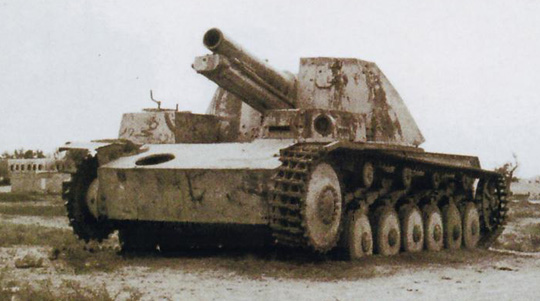
(The carcass of an Afrika Korps Bison in the Sahara in 1948, three years after the end of WWII. This was almost certainly not the one possibly used by Syria.)
During the Six Day War, an Israeli military unit was adamant that they had destroyed one Syrian Sturmpanzer II (the wreck was never found). Considering that the Bison’s overall rarity, this might be doubtful; then again the Sturmpanzer II was such an obscure vehicle that it doesn’t seem logical for the Israelis to even think of it unless they were sure that is what it was. During the 1958-1961 United Arab Republic era, both Egypt and Syria kept their armies distinct but there was a token nod to unity, and it’s possible that Egypt sent Syria one of these relics. A rebutting opinion is that the “Syrian Sturmpanzer” never existed, and that the Israelis had maybe mistaken it for a SU-100 or a StuG III.
Markings

(Markings on a Syrian army Panzer IV.)
Syrian vehicles of German origin were either painted in beige or a dark OD green. Almost all had the name of a Syrian soldier killed in a previous war on the turret in white. During the Six Day War, no national roundel was carried. However just as the conflict was starting, some had florescent red recognition triangles added. Syrian soldiers were notoriously trigger-happy and the decreased camouflage effect was likely cancelled out by the reduced odds of being blasted by a comrade.
Misconceptions
A myth is that Wehrmacht veterans trained the Syrians on the panzers or even helped operate them. By the time of the Six Day War, any German who had operated these vehicles during WWII would have been in his 40s or older. The last batch of German POWs had finally been released by the USSR in 1956 and few Wehrmacht veterans wanted to get anywhere near the Soviet military, by then Syria’s main ally. There may have been a small East German military advisor team in Damascus during the mid-1960s (certainly there was a significant one by the time of the Yom Kippur War in 1973) but the communist regime in East Germany would have never sent WWII veterans on a sensitive overseas mission; and whatever aid East Germany was providing was to support Warsaw Pact-standard weapons, not WWII relics.
Another story is that after Syria’s defeat in the Six Day War, some surviving panzers were shipped to Cuba (other versions place it before the war). This is untrue; for starters the Syrians were scrounging the planet for any weapon they could get their hands on and common sense dictates they would not at the same time be doling out tanks to the Caribbean.
Organization
Before the Six Day War, the Syrian army was surprisingly unorganized considering the amount of money being pumped into it. There was no unit larger than a brigade, and the whole Syrian army had a sort of “hub & spokes” system originating in Damascus, with every individual formation answering directly to the GHQ rather than a chain of command.
The Panzer IVs and StuG IIIs were in three independent tank battalions, grossly understrength, supporting the normal tank battalions of three infantry brigades (the 8th, 11th, and 19th) in the Golan Heights. The Jagdpanzer IVs were apparently in a separate independent platoon attached to a tank battalion operating T-34s and SU-100s. How the Hummels were assigned is unknown.
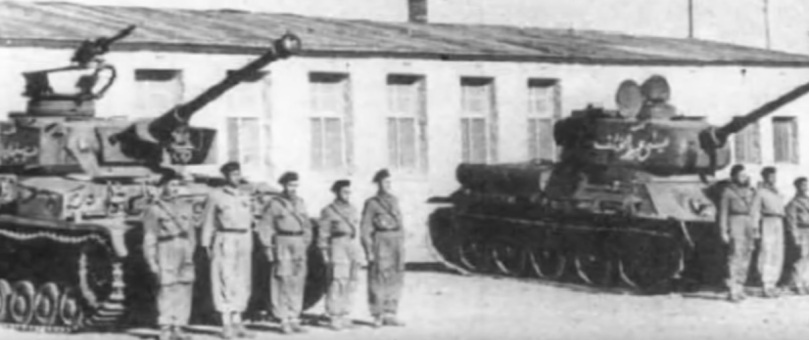
(Syrian army Panzer IV and T-34 in the mid-1960s. During WWII these two tanks had of course been arch-rivals on the Ostfront. This photo shows the DShK in place on it’s AA mount.)
IN COMBAT
the Water War
This was not really a war but rather a series of skirmishes between Israel and Syria during the mid-1960s.
With increasing frequency starting in 1964, Syria emplaced tanks on the western slope of the Golan Heights, almost directly on the border, to fire down on Israeli irrigation workers and farmers in the Galilee region. Surprisingly (considering the small number available) Syria chose the Panzer IV for this task. It had no feature making it better or worse than any other tank; most likely the Syrians felt they were the most expendable tanks in their inventory as Israeli counterfire was expected. The panzers were in defilade (dug in) and not easy to shoot back at; due to their altitude advantage.

(Syrian Panzer IV in defilade in the Golan Heights when they still belonged to Syria, looking down on Israeli farms in Galilee. This photo was taken after Israel overran the area during the Six Day War, and the tank had been abandoned for some time.)
In 1964, Syria announced plans to divert 35% of the Jordan River’s flow away from Israel, to deprive the country of drinking water. The Israelis responded that they would consider this an act of war and true to their word, engaged the project’s workers with artillery and sniper fire.
In 1965, Israeli M4 Shermans inside Israel exchanged fire with the Syrian Panzer IVs above inconclusively. A United Nations peacekeeping team ordered both sides to disengage from the border for a set period of time to “cool off”. The UN “blue berets” were detested and considered useless by both the Israelis and Syrians, and both sides used the lull to prepare their next move. When the cooling-off period ended, the Syrians moved Panzer IVs back into position. Now, the IDF had Centurion tanks waiting for them, with their fire arcs pre-planned out. The Cold War-era Centurion had heavy armor, a high-velocity 105mm gun, and modern British-made optics. It outclassed the WWII panzers in any imaginable way and almost immediately, two Syrian Panzer IVs were destroyed. Others were abandoned by their crews and that was the end of the situation.

(Syrian Panzer IV knocked out by an Israeli Centurion.)
the Six Day War
Syria’s participation in this 1967 war was was sloppy and ultimately disastrous. Israel initially intended the conflict to be limited to a preemptive strike against Egypt to forestall an imminent attack by that country, with the possibility of having to fight Syria and Jordan defensively if they responded to the operations against Egypt. The war against Egypt started on 5 June 1967.
Because of the poor organization of the Syrian army, news passed down from Damascus on the fighting in the Sinai was scarce and usually outdated by the time it reached the brigade level. Many Syrian units (including the GHQ) were using civilian shortwave radios to monitor Radio Cairo which was spouting off outlandish claims of imaginary Egyptian victories, even as Israeli divisions were steamrolling towards the Suez Canal.
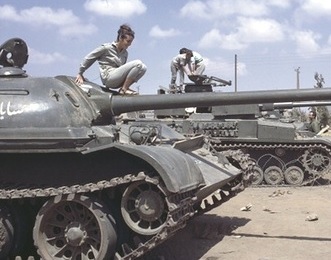
(In 1967, Syria’s main tank types were the Cold War-era T-54/55, here in the foreground, the WWII-vintage T-34, and (in far fewer numbers) the Panzer IV, here behind the T-54/55.) (photo via Manuel Litran)
During the evening of 5 June, Syrian generals in Damascus urged the government to take advantage of the situation and mount an immediate invasion of Israel. Planning and preparation was literally limited to a few hours after midnight, and shortly after daybreak on 6 June, Syrian commanders woke up with orders to invade Israel. The three infantry brigades in the Golan, backed up by several independent battalions, were to spearhead the attack as the rest of the Syrian army mobilized.
There was no cohesion at all. Separate battalions began their advance whenever they happened to be ready to go. Brigades went forward missing subunits that lagged behind. A platoon attempting a southern outflank maneuver tried to ford the Jordan River in the wrong spot and was washed away. According to the KGB, at least one Syrian unit “exhibited cowardice” and ignored it’s orders altogether.
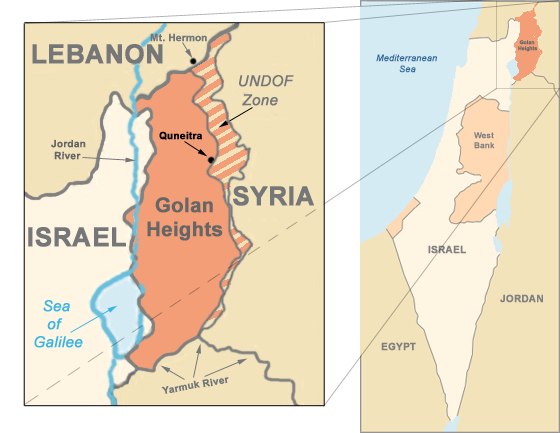
On 7 June, 24 hours into their attack, Syrian forces had only advanced 2 miles into Israel. On 8 June, the IDF pushed the Syrians back to the prewar border and that afternoon, Israeli units eliminated the last Egyptian forces in the Sinai and began a fast redeployment of units back into Israel. Now the Syrians were facing serious problems.
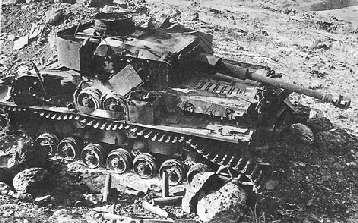
(Wreckage of a Syrian Panzer IV in the Golan Heights in 1967. Spent shell casings are around the tank, indicating it got some shots off before it’s destruction.)
On 9 June, Israeli forces crossed into the Golan Heights. They came by the route the Syrians least expected, an arc hugging the Lebanese border. Now for the first time, Syria’s panzers (considered too slow and fragile for the attack) were encountered. The next day, 10 June 1967, was an absolute rout as the Syrians were being attacked from behind by IDF units arcing southwards from the initial advance, plus Israel’s second wave coming from the west. It was later estimated that Syria lost between 20-25% of it’s total military vehicle inventory in a 15-hour span on 10 June. A ceasefire was announced at midnight, ending Syria’s misadventure. Syria permanently lost the Golan Heights to Israel.

(A pair of destroyed Syrian Panzer IVs in the Golan Heights after the Six Day War.)

(Syrian Panzer IV abandoned by it’s crew in the Golan Heights. The spraypainted “94” was applied by the Israelis after the ceasefire, during a census of destroyed vehicles to estimate how much damage they had inflicted on the Syrian army.)
Fate of the Syrian ex-German WWII vehicles
Syria had about two dozen StuG IIIs operational on 6 June 1967, plus another dozen or so non-operational. During their advance into the Golan Heights, the Israelis found that most had been put into defilade positions. Meanwhile others, perhaps from the non-operational total, had previously been half-buried as makeshift pillboxes in strategic locations.

(Destroyed Syrian StuG III in the Golan Heights. This was one that had been half-buried as a makeshift pillbox before the war.)
Three Syrian StuG IIIs were confirmed destroyed by Israel, no doubt there were more. One operational StuG III was captured intact and taken to Israel as a trophy. Many more, perhaps the remainder of the operational quantity, were sabotaged then abandoned by their crews during the 10 June rout when it appeared that the whole Syrian army might be encircled. The StuG III was never again mentioned by the Syrian army.

(A UN peacekeeper atop a knocked-out StuG III after the Six Day War.)

(The StuG III which Israel captured intact in 1967, here at an Israeli museum in 2004.) (photo by David Pride)
Little is known about the Hummels, of which five were in active service on 6 June 1967. One Israeli intelligence assessment concluded that all five had mechanical problems and could not be mobilized before the war ended. It was considered that alternatively, they were destroyed by IDF counter-battery fire beyond the ceasefire line, where their wrecks could not be seen. Like the StuG III, Syria never again mentioned the Hummel.
Syria had six Jagdpanzer IVs operational on 6 June 1967. One was destroyed by an Israeli tank. Surprisingly, the remaining five were retained by the Syrian army. They made no appearance during the 1973 Yom Kippur War. During the Desert Shield / Desert Storm period in 1990-1991, when Syria and the USA were briefly allies, the remaining five Jagdpanzer IVs were listed as “arsenal-level (long-term warehoused) assets” at al-Zabadani army base north of Damascus. In the mid-1990s, the late King Hussein of Jordan (an avid tank history fan) attempted to buy one or all of them for his army’s museum collection, apparently without success. During the 2014-onwards Syrian Civil War, they were likewise not seen, so apparently they had either been scrapped around the turn of the millennium, or destroyed in the warehouse during the civil war.

(This Syrian Jagdpanzer IV took a catastrophic penetration through it’s glacis in 1967; during WWII this was considered the most-protected area of the vehicle.)
By best estimate, Syria had twenty-five Panzer IVs fully operational on 6 June 1967, with maybe another ten or so partially operational or at least functional enough to take into combat. Most if not all of the ex-French batch was probably out of service by 1967, conversely the entire ex-Spanish lot was in use; along with some of the ex-Czechoslovak machines.

(Syrian Panzer IV; this one was most likely from the ex-Spanish batch. A Syrian StuG III is behind it; both captured by Israel in 1967.)
In addition to the pair already destroyed by Israel during the Water War, IDF tanks and aircraft destroyed (at a minimum) ten Panzer IVs during the Six Day War.
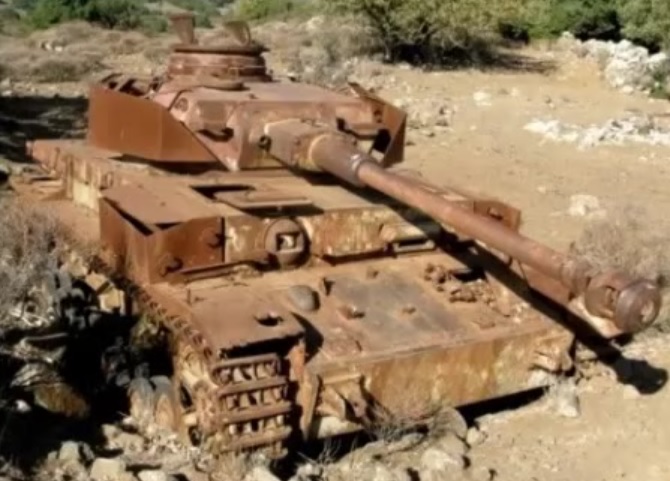
(Syrian Panzer IV Ausf J destroyed in 1967. The Golan Heights were heavily land-mined and littered with UXO after the war, and the area itself is rugged terrain difficult to tow vehicles out of. Wrecks which the Israelis felt of low intelligence value were often just left to deteriorate.)
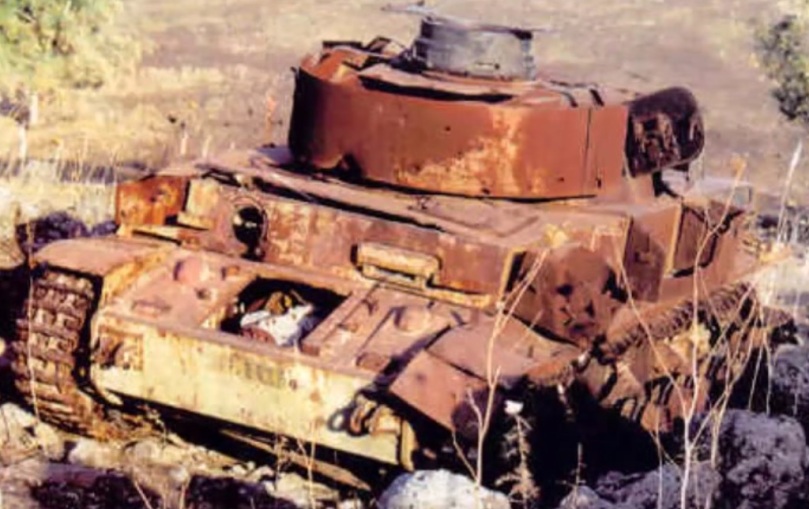
(Another destroyed Syrian Panzer IV. This is a “Frankenstein” with parts of the Ausf D, H, and J versions.)
The last kill was on 10 June 1967 when a Panzer IV was destroyed by an Israeli M50 Super Sherman. This tank was a M4 Sherman hull fitted with a new American engine, and a modified turret housing Israeli electronics and a high-velocity French-made 75mm gun firing HEAT rounds. Like the Centurion, the Super Sherman outclassed the Panzer IV.

(Israeli upgraded M50 Super Sherman tank and 4×4 recoilless rifle carrier; both grave threats to the unmodified WWII panzers.)
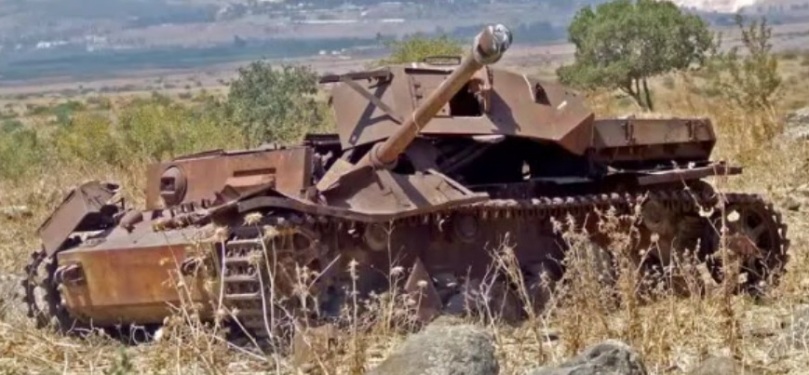
(This Syrian Panzer IV near Mt. Hermon was “racked” (suffered a penetrating hit resulting in it’s ammunition exploding) during the Six Day War.)
Four more were captured intact and taken to Israel as trophies. As these relics obviously had zero intelligence value, they went straight to museum display. Two additional Panzer IVs were knocked out but stable enough to move and taken back to Israel, being used for evaluation of how Israeli ammunition had performed.
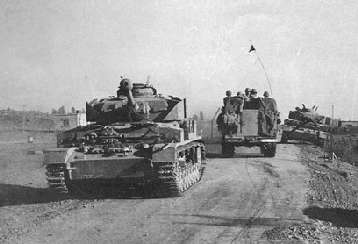
(A captured Panzer IV heads west towards Israel while IDF mechanized infantry advance deeper eastward into Syria. Another Panzer IV sits disabled on the road’s shoulder.)
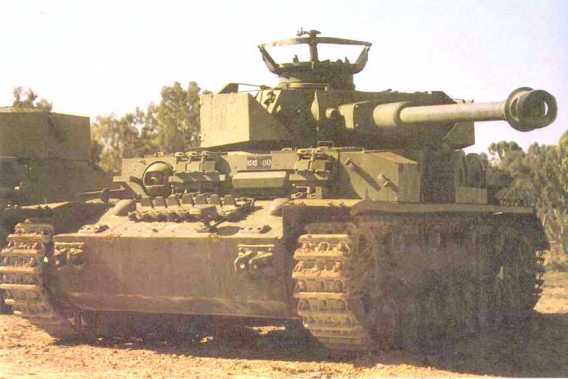
(A different Syrian Panzer IV, here an Ausf G, captured intact.)

(The same tank as above after it arrived at a collection point inside Israel. It has markings (in Hebrew letters) “mem mem 80” which doesn’t fit into any known IDF serial scheme and may have been some sort of local inventory number.)

(The same tank as above, today in an Israeli museum.) (photo by Janko Paliga)

(The tank’s placard at the Latrun museum.)
Since Syria used (and lost) those in the best condition, the bulk of the remaining two dozen or so Panzer IVs would have been in a marginal material state. Some of the survivors of the carnage on 10 June had mechanical issues. In the end, it did not really matter much. After the conflict, it was clear that WWII panzers had no place on a modern Cold War battlefield. As far as is known, they did not destroy a single Israeli tank. While it is a credit to German industry that they were even running at all 22 years after WWII ended, clearly it was a mistake to try to use them against Cold War-era tanks.
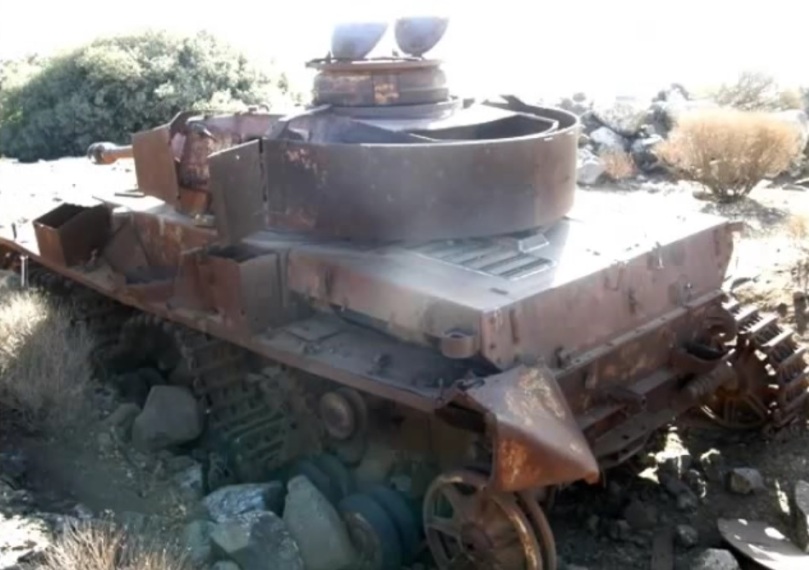
(Rusting wreck of a Syrian Panzer IV. This shows how the Schürzen panels had one-way hinges to allow use of the turret side scuttles.)
Between 1964-1973 the USSR rebuilt the entire Syrian military from the ground up, reorganizing it along Warsaw Pact lines and equipping it with gear strictly of Soviet origin. There was no place for ex-Wehrmacht tanks and in any case, Czechoslovakia had ended spares & ammo support for the Panzer IV, so the type had no future. The surviving Panzer IVs were scrapped in Syria, except for one sold to a collector in Jordan.
The Six Day War was the final time WWII German panzers were used in combat anywhere in the world.

(Like a ghost from the past, successive layers of post-WWII paint have corroded off this destroyed Syrian Panzer IV, showing a faint outline of the German balkenkreuz.)

Reblogged this on .
LikeLike
[…] SEPTEMBER 4, 2016 JWH19751 COMMENT […]
LikeLike
Regardless of their performance in the Arab – Israeli conflicts, it’s certainly a record that would be difficult to match in any other military vehicle.
LikeLiked by 1 person
Except by its two most common WWII adversaries, M4 Sherman and T-34-85, both of which are still in service in some places.
LikeLiked by 1 person
This is true but not directly applicable. The Shermans which Israel used in 1967 were almost all of the M50 and M51 upgrades. The T-34-85s the Arabs used were a quantity, not quality, asset and fared poorly in that war and even worse during the Yom Kippur War. The only Shermans I know of still in use today are in South America and are basically a sad case of penury of those armies, not any relevant military asset. The T-34s still rumbling around Yemen and North Korea are in a similar situation.
LikeLike
[…] Source: Panzers in the Golan Heights […]
LikeLike
I find it odd that despite all of your research here (sources would be nice) you still refer to the M-50 as a “Super Sherman” despite the fact that “Super Sherman” was only ever used for the M-1 Sherman, and not the M-50 and M-51.
LikeLiked by 1 person
Thanks for your response, all the sources I have ever seen refer to the M50 as the Super Sherman and the M51 as the Isherman (or Y’shrmn, depending on how you transliterate the Hebrew). Neither name was IDF “official”. The IDF M-1 designation equates to the US Army’s M4A1 version of the Sherman.
LikeLike
Look up Thomas Gannon’s Israeli Sherman book, as well as Dr. Manasherob’s Lioness & Lion of the Line series. Both provide excellent histories of the Sherman in Israeli service, as well as clarify that the M-50 and M-51 were never called Super Sherman. Super Sherman is only seen specifically in relation to a shipment of 76mm armed Shermans acquired from France in early 1956. If I had to guess as to where the name came from, I would say it started with either a modeling company that thought the name was far cooler than M-50 or M-51 (wouldn’t be the first time a modeling company invented a name for an armored vehicle), or perhaps an author who thought the same thing.
As for the M-1 designation, it does not in fact refer to an M4A1 model of Sherman, but to any 76mm M1A1/M1A2 armed Sherman in Israeli service. Doesn’t matter if it’s an M4A1, M4A3, M4A3E8 or M4A1E8, if it had the American 76mm M1A1 or 76mm M1A2, it was called M-1. Likewise, any Sherman armed with the 75mm M3 cannon was known as M-3, the French 75mm CN-75 50 armed Shermans were known as M-50 (including the rearmed M10 tank destroyers in Israeli service, no distinction was made), etc.
LikeLike
I spent te in sinai as a peacekeeper in 1989 /90 .
I visited several Israeli army bases and met many soldiers /tank drivers and mechanics and most if not all referred to the M50/51 as the super sherman !! .
LikeLiked by 1 person
[…] WWII After WWII has a great piece up on the use of German panzers as late as the 1960s by Syria in their wars against Israel. Acquired from Spain, Czechoslovakia and other sources, the Six Day War saw U.S.-made M50 Super Shermans and British Centurions in the hands of IDF tankers smoking Syrian Panzer IVs and StuG IIIs (some still with fading German balkenkreuzs) […]
LikeLike
Some eight years ago I came across a model diorama depicting a Syrian T-34 in tricolor camo. The author claimed that many Arabs painted their tanks in WW2 German tricolor camo to deter the Jews. Is this true?
LikeLike
I doubt it, the Israeli Defense Force’s first standard battle rifle was the 98k; and they also used the MG-34 and Avia’s postwar of the Bf-109.
LikeLike
This is a fantastically well-detailed and well-researched article that fills a great void. I first encountered the German armor that remains “in situ” in the Golan in the mid-1990s as a US Army attache in Israel. I’ve visited the Mk IV left as a memorial to the IDF’s attack on Tel Aziziat and the Mk IV and dug-in StuG III that are near the Lebanon border north of Kibbutz Dan. At the latter location, I photographed a road wheel lying on the ground next to the Mk IV, the rubber tire of which was marked “Made in France.” Also, there’s a Sherman in a stand of trees near Kibbutz Ein Ziwan that has French-language data plates and writing inside – perhaps one of the Shermans secretly delivered by France to Israel shortly before the 1956 Suez crisis?
LikeLiked by 1 person
[…] Panzers in the Golan Heights […]
LikeLike
Great article. I am currently building a Dragon 1/35 Syrian Panzer model kit. This article provided some interesting background info.
LikeLiked by 1 person
Interesting and well researched article. The most important piece of information dispels the rumor running after the Six Day War that five ex-Turkish Pzkw Mark IV were donated and emplaned on positions at the Golan Heights with WW II German Army paint jobs to remind Israel that some people consider there is still a job to be completed; the extermination of every Jew. Truth is, Syria is bankrupt and was scrounging for whatever military hardware they could lay their hands on.
LikeLiked by 1 person
Three years ago I found the footage of Syrian Panzer IV in maneuver on Syrian National TV.
Possibly filmed during the Water War?
Posted on YouTube.
LikeLike
Thank you, I have never seen a video of them before!
LikeLike
The video is probably during the UAR period 1958-1968. Because the commentator is a well-known familiar Egyptian voice who used to comment on all the official film-tv broadcasts. 2 well known high Syrian officers are discerned in the clip: Salah Jadid and Abd al Hamid al Sarraj. The latter appeared in civilian dress during the UAR period as he became a minister. So my guess would be: a film take before 1958, but issued after the unity with Egypt took place.
LikeLiked by 1 person
In the pic described as (Markings on a Syrian army Panzer IV.) , name of “Adnan al-Malki” is written on the turret.
He’s Baathist colonel of Syrian Army assassinated by SSNP.
LikeLiked by 1 person
The following video suggests that the Pzkpfw IV managed to knock out a few Israeli tanks:
I tried to contact the uploader to get some confirmation of the claim, but he never replied.
Perhaps you can look further into this?
LikeLike
Thanks, I have seen that video on YT and I think it mixes up a few things; for example when they are talking abiut the 6 Day War they show clips of IDF Super Shermans from the Yom Kippur War and a knocked-out Egyptian M4 from the Suez conflict. The Israelis felt that no armor had been destroyed by ex-German vehicles and they were pretty methodical in tracing the cause of every vehicle lost in the conflict.
LikeLike
[…] pendukung dari MBT Suriah lainnya yang jauh lebih modern. Post By : RARW Tag : #rww_tanks Sc : https://wwiiafterwwii.wordpress.com/2016/09/04/panzers-in-the-golan-heights/ #syria #israel #idf #sejarah #militer #tank #panzer #infodunia […]
LikeLike
i know im super late however its written on the panzer 4 that later came to latrun
“mem mem 80” which doesn’t fit into any known IDF serial scheme and may have been some sort of local inventory number.
its not an inventory number mem mem (ממ) is the Israeli abbreviation for millimeter like mm, it says 80mm because the panzer 4s front plate is 80mm thick
LikeLike
[…] Rebuild Panzer IV’s https://www.mmowg.net/czech-medium-tank-t-4075/ https://wwiiafterwwii.wordpress.com/2016/09/04/panzers-in-the-golan-heights/ […]
LikeLiked by 1 person